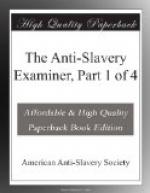With regard to those white men, who, it was said, did try to raise an insurrection in Mississippi a year ago, and who were stated to be Abolitionists, none of them were proved to be members of Anti-Slavery Societies, and it must remain a matter of great doubt whether, even they were guilty of the crimes alledged against them, because when any community is thrown into such a panic as to inflict Lynch law upon accused persons, they cannot be supposed to be capable of judging with calmness and impartiality. We know that the papers of which the Charleston mail was robbed, were not insurrectionary, and that they were not sent to the colored people as was reported. We know that Amos Dresser was no insurrectionist though he was accused of being so, and on this false accusation was publicly whipped in Nashville in the midst of a crowd of infuriated slaveholders. Was that young man disgraced by this infliction of corporal punishment? No more than was the great apostle of the Gentiles who five times received forty stripes, save one. Like him, he might have said, “henceforth I bear in my body the marks of the Lord Jesus,” for it was for the truth’s sake, he suffered, as much as did the Apostle Paul. Are Nelson, and Garrett, and Williams, and other Abolitionists who have recently been banished from Missouri, insurrectionists? We know they are not, whatever slaveholders may choose to call them. The spirit which now asperses the character of the Abolitionists, is the very same which dressed up the Christians of Spain in the skins of wild beasts and pictures of devils when they were led to execution as heretics. Before we condemn individuals, it is necessary, even in a wicked community, to accuse them of some crime; hence, when Jezebel wished to compass the death of Naboth, men of Belial were suborned to bear false witness against him, and so it was with Stephen, and so it ever has been, and ever will be, as long as there is any virtue to suffer on the rack, or the gallows. False witnesses must appear against Abolitionists before they can be condemned.




